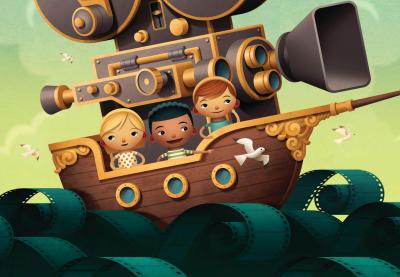“I was surprised that Iran was so much like us. Kids are playing, having fun, adults yelling, a lot of work was being done, and kids were sad. This movie was humorous and heartbreaking.”
—Clissold Elementary School student, Chicago
There is a natural human tendency, when learning about people of races, ethnicities, religions or nationalities other than our own, to focus on differences. But focusing exclusively on differences can make members of an unfamiliar group seem exotic or even alien (with all the negative connotations of that word).
Teaching with foreign films is one way to help students engage with stories that may be geographically, linguistically or culturally distant but explore themes that connect people across space and time. Consider these descriptions:
- A boy with undiagnosed dyslexia is bullied by his classmates, but ultimately becomes a celebrated artist.
- A young girl demonstrates her talents and work ethic, but is bypassed for a leadership role in favor of the boys in her class.
- A boy feels desperately lonely when his single mother leaves him in the care of his grandmother, but grows to love and appreciate his new caregiver.
These plotlines—from Like Stars on Earth, Whale Rider and The Way Home respectively—give students a close-up view of ordinary people living in different countries and offer opportunities to focus on common human experiences. Children coping with deprivation in Tehran, Iran, may experience emotions similar to children in your classroom who have no winter coats. A boy who struggles in your own school with an undiagnosed learning difference may be inspired by a similar character who becomes a successful student with the right scaffolding.
Pair these connections with the experience of watching a film in class and “the effect can be electrifying,” says Melinda Barlow, writing for NEA Today. “Look around during a screening and you will see everything from nods of recognition to traces of agitation, and hear gasps of fear or delight. Reactions to films are often involuntary, and verbal responses are just
as visceral.”
Windows and Mirrors
International films offer wonderful opportunities to implement an instructional approach that Emily Style, founding co-director of the National SEED Project, refers to as using “windows and mirrors”: Students can see themselves and their own lives reflected in these films, gaining a greater awareness of themselves and their relationships with their families and communities; they can also see into other cultures through a scaffolded experience that encourages openness, acceptance and curiosity to learn more. A teacher in Tulsa, Oklahoma, told Journeys in Film this story about a young student who watched The Way Home and studied the accompanying Journeys in Film curriculum.
“He was so touched … that he earned money to purchase the movie! Money doesn’t come easy for this young man, and he worked hard to buy it. He felt it was the best movie he had ever seen,” she said. “[He] has had a lot of obstacles to overcome in his life, and a lot of kids this age enjoy tormenting him. I can’t explain it really, but watching The Way Home somehow changed [him].”
When selected carefully, international films can convey the complex reality of life in other countries and cultures more vividly and memorably than a textbook can. A talented filmmaker uses color, action and sound to communicate meaning. The Cup is a great example of how a film can communicate a message about modernization and the technology gaps between rich and poor better than a lecture. Students who watch The Cup see the lengths that a teenage Tibetan Buddhist monk goes to in order to bring a television to his monastery and fulfill his dream of seeing a World Cup soccer game: soliciting funds, renting the television and generator, stringing wire and setting up a satellite dish in a centuries-old building.
The characters in a well-chosen foreign film can build an emotional bond with the viewer that leads to positive, open feelings about the culture portrayed in the film and contextualizes the diversity of lived experiences around the world. One sixth-grade teacher in a New York City school commented that teaching foreign films “primed my students to think on a global level and opened their awareness to cultural difference.” Her class was studying human rights violations and the refugee crisis in Darfur, Sudan, when they watched The Cup. The combination helped her students become more observant and more sensitive to cultural nuances. “My class was determined to get involved. We got in touch with a UN Human Rights Commission officer in Darfur and interviewed him via email. That dialogue provided an in-depth understanding of the situation, making it extremely real for us.”
It can be tempting to use foreign films as a way to highlight problems that students in the United States rarely have to encounter. To avoid establishing an “us-versus-them” viewing dynamic, select films that are not set exclusively in developing countries and do not focus exclusively on topics like poverty and war. Children of Heaven deals not only with poverty but with economic diversity; viewers see the wealth and urbanity of downtown Tehran and its upscale housing developments. Whale Rider is set in New Zealand, which enjoys a per capita income comparable with Japan’s. The main character of The Way Home has grown up in Seoul, South Korea; part of his struggle is that he is used to the same video games, Western-style fast food and modern conveniences as U.S. students.
But What About the Standards?
Regardless of the state in which they work, all teachers must design their curricula to meet content and skill standards. When treated as texts, international films can help meet these standards. The key is setting up the films so students are not simply viewing them passively and moving on. International films lend themselves well to building challenging lessons that prepare students to “read” the films closely; discuss the cultural nuances; interpret the plots orally or in writing; and analyze the storytelling techniques. Films can also be used as a springboard to lessons in other disciplines.
Consider these Common Core anchor standards for reading:
- CCSS.ELA-Literacy.CCRA.R.2
Determine central ideas or themes of a text and analyze their development; summarize the key supporting details and ideas.
- CCSS.ELA-Literacy.CCRA.R.3
Analyze how and why individuals, events or ideas develop and interact over the course of a text.
Social studies teachers can also meet Common Core standards with film. The film may be the carrot that arouses student interest in world history, anthropology or international relations; teachers can follow up a viewing with lessons based on reading, statistics, maps, photographs or other primary sources that will strengthen, enrich or even contradict impressions gained from the film. Lessons based on international films offer opportunities to meet these grade-level standards for literacy in history and social studies:
- CCSS.ELA-Literacy.RH.6-8.7
Integrate visual information (e.g., in charts, graphs, photographs, videos or maps) with other information in print and digital texts.
- CCSS.ELA-Literacy.RH.6-8.9
Analyze the relationship between a primary and secondary source on the same topic.
Best Practices for Showing International Films
Educators who want to get serious about using film effectively in their instruction should consider reading one of several excellent books on the topic: Reel Conversations: Reading Film With Young Adults by Alan B. Teasley and Ann Wilder and Reading in the Dark: Using Film as a Tool in the English Classroom by John Golden are good general works. Another suggestion is to seek out books that address stereotyping in film, such as Reel Bad Arabs: How Hollywood Vilifies a People by Jack Shaheen.
Journeys in Film has been selecting and writing curricula for exceptional, classroom-appropriate international films for a decade. Here are some best practices based on educator feedback over the years:
- Let administrators and families know before you show the film, and explain briefly how the film enriches your curriculum. (This is particularly important if the film has controversial elements.)
- If possible, show the film in the auditorium on a large screen.
- If time permits, show the film once in full for students to enjoy and get the general message. Then show clips correlated to each lesson. Consider teaming up with other teachers in your school and have a special showing at an assembly, or divide the film between the English and social studies teachers so each teacher uses only one period.
- Prepare students for reading subtitles. Adults watching a subtitled film usually become sufficiently involved in the story that their reading of subtitles becomes automatic. The same will happen with most students as they become absorbed in the story and characters. For students who have difficulty reading or for ELL students, consider having older or more advanced students read the subtitles aloud. Give the readers a chance to preview the film, and be sure to introduce them at the start of the screening.
- Use preview lessons to establish the context of the film, and provide the necessary information for understanding so that students do not become confused or distracted. Journeys in Film’s preview lesson plans often establish a geographical perspective or provide cultural information.
- Use interdisciplinary lessons when possible to address a variety of student interests and learning modes. Team teaching is ideal for this. For example, if you were showing the film Whale Rider, you could ask a social studies teacher to teach about who the Maori are, a science teacher to teach about whales’ use of echolocation, a math teacher to present a lesson on methods of estimating whale populations, an art teacher to give a hands-on lesson on Maori tattooing traditions, and a language arts teacher to address character, theme and filmmaking techniques.
- Become familiar with copyright and fair use doctrine as related to curricular use. In general, if you are using a film as part of your curriculum, with lessons based on the film, you meet fair use guidelines; just showing a movie does not. A summary of the law can be found at k12.movlic.com/copyright.
With these practices as your guide, your journey into the world of international films should be an adventure that captures your students’ imaginations and challenges their minds. In some cases, the effects can be transformative. The young man who fell in love with The Way Home joined an honors course and reports a better relationship with his parents. His teacher now describes him as “a happy young man with a purpose.”


